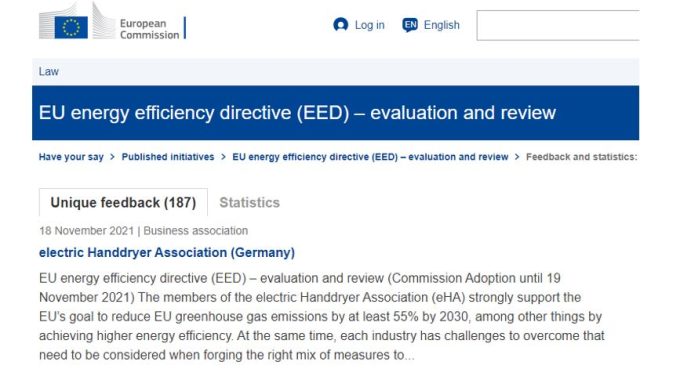New Global Trends in Commercial Restroom Design: Enhancing User Experience, Health, Sustainability and Savings.

eHA Statement: EU Energy Efficiency Directive (EED)
The members of the electric Handdryer Association (eHA) strongly support the EU’s goal to reduce EU greenhouse gas emissions by at least 55% by 2030, among other things by achieving higher energy efficiency. At the same time, each industry has challenges to overcome that need to be considered when forging the right mix of measures to achieve these goals. eHA has already commented on the European Commission’s impact assessment and seeks to re-emphasize that a significant increase in energy efficiency requires a holistic approach.
Lifecycle energy use to be considered
Specifically, sustainable reduction of energy efficiency needs to take different aspects of the energy use of the entire lifecycle of products into account.
Most importantly, not only energy-using products, but also of those that may not require energy when in use, need to be taken into account: notably when they are prone to serve as substitute products for other market offers. The eHA is emphasizing this factor because its members face potential competitive disadvantages, if not actual commercial harm, due to a lack of such consideration under ecodesign measures that are derived from the current ecodesign directive. Our experience shows that the potential loss of sales due to new energy efficiency requirements will not be compensated with sales in dryers that meet higher energy efficiency levels, but part of these sales will be replaced by another drying system with a lower initial investment: Paper towel dispensers.
Hand dryers and paper towels are fully substitutable products. In the long term, hand dryers are cheaper, but the short-term investment is lower for paper towels.
In the current economic situation, products that require minimal investment are more in demand. Paper towels may not be energy-consuming when in use for hand-drying, but they have a heavy ecologic footprint. The average paper towel generates 7.5gms/CO2 or 22.5 gms/CO2 per dry.
Life Cycle analysis shows that the effects of felling raw materials, transportation, manufacturing, packaging, storage on a constant loop, significantly produces a lot of CO2 into the atmosphere. One ton of virgin paper towels consumes 17 trees, 75,8 m3 of water are consumed and polluted. To reprocess this water, a lot of energy is needed. Furthermore, this ton of paper produces more than 3 tons of CO2 emissions, and requires 12 m2 of landfill space. In addition, paper towels are contaminated waste therefore they all have to end up in landfill. In the USA alone, 6,500,000 TONS of paper towels are sent to landfills each year. The decay of paper products and landfills in general produces methane gases which are 28 times more potent than carbon dioxide, therefore a real threat to global warming. They are also often put in plastic bags, creating further downstream problems in the recycling process.
The 2030 climate targets can only be reached when paying attention to the interest in keeping waste low and product lifecycles long. With the revised Energy Efficiency Directive, the European Commission should offer a toolbox that allows to take into account the environmental and energy footprint of substitute products, even if those do not belong to the energy-consuming products when in use.
Lifecycle energy reduction potential to be considered
Finally, while it is important that every industry contributes its part to increasing energy efficiency, regulatory measures should aim at capturing those stakeholders with the highest energy consumption and the highest energy-saving potential first. To again cite the case of hand dryers: bringing the stand-by power usage down from 0,5-2 w to below 0,5 w for the two thirds of all hand dryers that are still within that range would require investments that cannot be justified by the energy efficiency gains, especially when taking into account that these products have life spans of 20+ years and will only be replaced when necessary.
On the other hand, electric hand drying has a major economic advantage when it comes down to cost per dry, especially when compared to substitute products such as paper towels. Giving the following example: Highly efficient electric hand dryer runs 100 times/day. Energy costs 0,318 Cent/kWh (average Germany 2020), cost per paper towel: 0,025 Cent/dry. Over one year (365 days), operating costs hand dryer = 35,47€; paper towels: 912,50€. To put it the other way around: Highly efficient dryer can be run round about 580 times per kWh (base: 1,7 Wh/10 seconds dry), costs/kWh = 0,318€. 580 times using paper towels (0.025€/use) = 14,50€.
Previous impact assessments do not consider such factors in a broader comparison. The revised Energy Efficiency Directive should
Conclusions
The hand dryer industry has a vivid interest in improvements of their products. The innovative power has been demonstrated over the past decades. However, energy efficiency will only be achieved if all products, whether they require energy when in use or not, and especially those that can substitute for each other, are taken into consideration when determining measures to achieve true improvements in energy efficiency.


